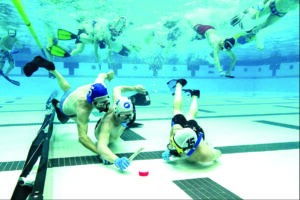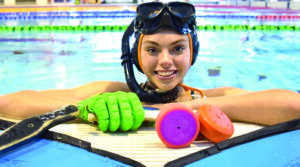By David Mullen
Currently amid a searing hot regular season, what happens if the ice melts under the Dallas Stars? No fear. They can play underwater hockey, more commonly known as UWH, in the Dallas-Fort Worth Underwater Hockey League.

Photos courtesy of Dallas-Fort Worth Underwater Hockey
Dallas is looking to keep their heads above water in the playoff race against their rivals in Winnipeg, Vegas, Denver and Minneapolis-St. Paul. But if things don’t work out for the current Central Division leaders, the Stars could still make a splash. UWH is very much afloat in the area.
“Basically, in underwater hockey, the pace moves a lot slower because of the friction of the water,” said Charles Cook, manager of the Dallas-Fort Worth Underwater Hockey League. “There is no rule like icing. No such thing as offsides. Launching a pass with the puck usually doesn’t go more than three feet.” A UWH puck looks like an ice hockey puck in size and is covered in plastic. But to make sure that the puck sinks to the bottom and stays, it can weigh more than three pounds.
Like ice hockey, the premise of the game is to score a point by pushing a puck into a goal with a stick. But UWH is played at the bottom of the pool. The smoother the pool surface, the better. Teams face each other underwater with the intention of scoring the most goals. Two halves can be 10 or 15 minutes each.
A player’s gear looks much different than worn by their frozen friends. A conventional uniform consists of a snorkel, hat, masks, fins, a stick and a glove on one hand reminiscent of Michael Jackson. The short sticks fit in the palm of one’s hand and are made of plastic or wood. In the local league, the sticks are black or white to differentiate teams.
Swimsuits are required. “We prefer to wear Speedos, just to keep the drag off of us,” Cook said. Women wear friction resistant one-piece suits.

Ten-person squads make up teams of four (in non-competitive matches), five or six players on each side during play. In an Olympic size pool, the game is played across swimming lanes and not the length of the pool. The goal is not a net because a player doesn’t fire the puck at lightning speed. The scoring area is often designated by a trough or a rope where a puck can be flicked toward or pushed against it.
“We don’t do goalies,” Cook said. “We have our forwards and our backs. The forwards score the goals, and the backs defend. We don’t have goalies because not one person can be down there for a length of time.”
Final scores are more emblematic of soccer than the NHL. “It can range from 1-0 to 10-5,” Cook said. A 3-2 game is a good indicator. If a player scores a hat trick, there are no reports of swim caps being tossed into the pool.
Penalties are rare. There is no underwater penalty box. More severe penalties, usually given in tournaments when referees are present, could result in an ejection causing the team to have one less player. “That would be the parallel with ice hockey and underwater hockey,” Cook said. In the NHL, players receive a two-minute penalty for slashing. In UWH, there is no penalty for sloshing.
Called Octopush in the UK, UWH is played worldwide. It has found popularity in the frozen tundra of Canada, the waterways of the Netherlands, the bonny banks of Ireland and down under in Australia. It has even surfaced in unlikely spots like Argentina, Brazil, China, Germany, Italy, Israel, Japan, Korea, the Philippines, the sand dunes of Saudi Arabia and near the Zambezi in Zimbabwe. No Zamboni is needed in UWH.
UWH is even played in the UAE.
The FIFA of underwater sports is the CMAS World Underwater Federation based in Rome, Italy and founded in 1959. It comprises more than 130 federations from five continents. The Underwater Society of America (USOA) is the national governing body for underwater sports in the U.S. and is a charter member of CMAS. The Dallas-Fort Worth Underwater Hockey League is sanctioned by the USOA.
“One of the downfalls of underwater hockey is that it is not a very good spectator sport,” Cook said. “That’s why we are having a hard time getting people interested in playing. If people can’t see it, they can’t understand it.” The league has set up an underwater camera to film the action, and pools with glass sides are being constructed in UWH hotbeds like Reno.
While it’s not easy, anyone can play UWE. “It takes getting used to,” Cook said. There are men’s and women’s divisions that vary in age from youngsters to seniors. Size doesn’t matter, as strength becomes counterbalanced in the water. The cardio benefits are obvious.
Practices are typically every Wednesday at Duncanville High School’s Natatorium. Cook said, “It’s at the high school that won the state football championship.” There is no 6A Division I title for underwater hockey, yet.
To find out more about UWH or upcoming events in the Dallas-Fort Worth area, interested participants can contact Charles Cook at cook.charles@ups.com or go to the Facebook page and search Underwater Hockey (Dallas-Fort Worth).
“You can YouTube it, too,” Cook said. In fact, several YouTube videos exist that show players in action. “We use the videos to recruit players.”
Cook, 49, is a Dallas native and active scuba diver who discovered underwater hockey at Tarrant County Junior College. “What underwater hockey does, it evens out everyone’s physical aptitude. A little girl can take on a big strong man underwater. The water neutralizes our physical strength. We are all on a neutral playing field.” Or in a neutral swimming pool. Just watch out for the pint-sized enforcer in the “My Little Pony” swim cap. She’s tough.
